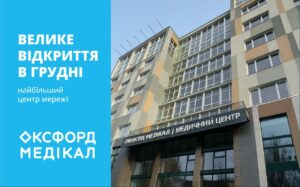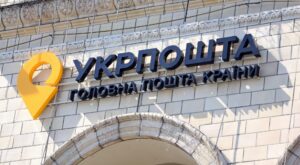
The Oxford Medical network of private medical centers celebrates its 20th anniversary and continues to work to provide continuous healthcare for Ukrainians. One of the incredible gifts will be the opening of the largest full-cycle medical center in the network at 7a Parkovo-Syretska Street, Kyiv, which will take place in December!
The first services to be available will include:
– Outpatient care in all areas: therapy, pediatrics, cardiology, gynecology, urology, dermatology, gastroenterology, neurology, aesthetic medicine, and others;
– Modern diagnostics: CT, MRI, mammography, X-ray, ultrasound (including 3D/4D), endoscopy, and laboratory tests.
Other departments will be opened in the future, including: a surgical department and inpatient ward, intensive care unit, therapeutic inpatient ward, pediatric department with inpatient ward, infectious diseases department, and others.
Oxford Medical is constantly improving. Our doctors regularly undergo training at leading European clinics, participate in international conferences, and implement modern diagnostic and treatment protocols.
We use only equipment from world leaders, which guarantees the accuracy and safety of procedures.
Emergency assistance with travel to any area of Kyiv or its suburbs arrives within 30-60 minutes, and appointments can be made online at https://oxford-med.com.ua/ and by calling +38 (044) 204 40 40.
We work – we heal!

The moratorium on the export of unprocessed timber from Ukraine, which was introduced on November 1, 2015, for 10 years, has been temporarily extended by a decision of the Cabinet of Ministers of Ukraine until the end of the year in the form of a zero export quota.
“At the request of businesses, the government has made an important decision to temporarily ban the export of unprocessed timber. This is a necessary step to take care of people in winter, preserve the work of our enterprises, and reduce the burden on the environment,” Ukrainian Prime Minister Yulia Svyrydenko wrote on Friday on Telegram following her trip to the Rivne region.
She noted that the volume of logging in Ukraine has significantly decreased during the full-scale invasion by the Russian Federation. “Enterprises that could be operating are idle or working at minimum capacity due to a lack of wood. The army needs wood for its own needs. Life in rural communities, where firewood is a key resource for heating in winter, depends on the availability of wood,” the head of government wrote.
In addition, according to Svyrydenko, the war has caused significant damage to the environment, as part of the forests are temporarily occupied or damaged by hostilities. “Therefore, timber exports will create an additional burden on the environment,” the prime minister noted.
“The decision provides for export licensing – a zero quota until the end of the year. We continue to work on further steps to systematically address the timber shortage,” Svyrydenko said.
The head of the State Forest Resources Agency of Ukraine, Viktor Smal, previously told the agency that according to the law adopted in 2015, the moratorium on the export of unprocessed timber of all tree species, except pine (a 10-year moratorium was introduced for pine on January 1, 2017), will end on November 1, 2025.
Smal clarified that the extension of the moratorium for the duration of martial law and for another 10 years after it is provided for in the draft law on the timber market, which is currently being prepared for its first reading.
“In my opinion, 10 years is definitely enough to recover from all these shocks in terms of production and investment,” said the head of the State Forestry Agency.
He believes that the moratorium has been beneficial because a large number of production facilities have expanded and opened in Ukraine. “If we look at the structure of our exports, we will see that the depth of our wood processing leaves much to be desired. We should try to make not boards, not beams, not pallets, but cribs, kitchen chairs, tables, and export them,” Smal added.
As reported, in January-August 2025, Ukraine exported $1,131.3 million worth of wood and wood products, which is 15.5% more than in January-August 2024. However, during the same period, wood and wood products worth $160.5 million were imported, which is 8.8% more than in January-August 2024.
During this period, wood and other fibrous cellulose materials worth $186.2 million were exported (19.1% more than in January-August 2024), and $594.3 million worth were imported (1.7% less than in January-August 2024).

The European Investment Bank is considering a EUR70 million project to supply Mykolaiv with drinking water.
“The sub-project aims to restore Mykolaiv’s access to drinking water after serious damage to its water supply infrastructure as a result of the destruction of the Kakhovka hydroelectric power plant by Russian troops in 2023. The implementation of the sub-project will bring significant environmental and social benefits, including improved water quality, reduced pollution, and increased energy efficiency,” the project description states.
In addition, temporary jobs will be created during the construction of infrastructure elements, the document notes.
According to information on the bank’s website, the beneficiaries of the financing are state bodies and companies. The project is part of the Ukraine Municipal Infrastructure Development Program, launched in 2015 with financing in the form of a EUR400 million framework loan.
As reported, in September 2024, the government reached preliminary agreements with the EIB to attract donor funds for the construction of a water intake from the Southern Bug River and a main water pipeline in Mykolaiv.
The EIB has been operating in Ukraine since 2007. Following Russia’s full-scale invasion in 2022, the Bank stepped up its financial support to help strengthen the country’s resilience and rebuild its infrastructure. Since then, the EIB has provided Ukraine with EUR 4 billion in financing.

The national postal operator Ukrposhta incurred a net loss of UAH 151.8 million in the third quarter of 2025, which is 10.4% more than in the third quarter of 2024, while it was planned to reduce the loss to UAH 56.2 million, according to the quarterly report.
According to the report, Ukrposhta’s revenue in July-September decreased by 6.2% compared to the third quarter of 2024, to UAH 3 billion 18.1 million, which is 18% less than planned, while EBITDA for the reporting period amounted to UAH 100.4 million against UAH 298.6 million in the same period of 2024.
The company emphasized that the main reasons for the deviations are the actual dollar exchange rate in the third quarter of 2025 being lower than the dollar exchange rate set in the state budget for 2025, on the basis of which the planned revenues for 2025 were formed, the loss of markets and company assets due to Russia’s continued aggression, and stagnant domestic demand for services, primarily for parcels and utility payments, due to the unfavorable economic situation.
Other reasons for the deterioration in financial results include delays in the introduction of additional services for customers, the transition of pensioners to the banking system, the further digitization of payments and population decline, as well as the postponement of real estate sales from the third quarter of 2025 to the fourth quarter.
It is noted that in the third quarter of 2025, Ukrposhta accepted 19.6 million domestic and international letters (20.6 million in the third quarter of 2024), 10.2 million parcels (11.3 million), and 20.8 million payments (21.7 million).
According to the report, Ukrposhta currently has 5,100 stationary points serving 11,100 service points and 2,000 mobile points serving 20,100 service points.
The average number of full-time employees in the third quarter of 2025 was 27,100 (30,200 a year earlier), and the average salary was UAH 18,500 (UAH 17,100).
Separately, information was added that a plan of measures to improve the financial situation was developed at the meeting of the supervisory board. In particular, this involves maintaining a delivery quality level of at least 95%, improving the customer experience, further integration with key customers and marketplaces to increase shipment volumes, and launching the first agency parcel delivery points and parcel terminals to improve pedestrian accessibility.
As for payments, the front-end system is being updated and a transition to a new payment system is underway, with revised payment rates to increase revenue. A decision has also been made to sell real estate that is not used in operational activities, and a gradual optimization of personnel is taking place in line with the reduced volume of traditional services (from 28,800 employees in January 2025 to 27,100 employees in September) and a deferred review of salaries for production personnel due to failure to meet financial targets.
Ukrposhta added that it plans to expand the functionality of its new mobile app for customers in the fourth quarter of 2025, where parcels, payments, and other services will now be automatically loaded. Preparations are also underway for winter, including a review of processes and routes, and the purchase of additional lights, power banks, and pallets.
According to the report, the outstanding portion of the EBRD debt amounted to UAH 1 billion 325.9 million at the end of the third quarter, with a maturity date of June 20, 2032.
As reported, in the first half of 2025, Ukrposhta increased its revenue by 5.4% compared to the same period last year, to UAH 6.505 billion, reducing its net loss by 27.2% to UAH 311.8 million.

JSC Dnipro Switch Factory (DnSZ, Dnipro), a major Ukrainian manufacturer of switches for main railway tracks, increased its net profit by 69.6% in January-September 2025 compared to the same period in 2024, to UAH 503.16 million.
According to the financial results report on the company’s website, net sales revenue for this period decreased by 2.7% to UAH 1 billion 542.5 million.
DnSZ received UAH 625.3 million in profit from operating activities (50% more), and gross profit amounted to UAH 657.1 million (+8.2%).
As reported, in the first half of 2025, the plant increased its net profit by 2.2 times compared to the same period in 2024, to UAH 249.2 million, with revenue growing by 24.2% to UAH 796.7 million.
Thus, in the third quarter of 2025, DnSZ increased its net profit by 39.3% compared to July-September 2024, to UAH 254 million, while net income decreased by 21%, to UAH 745.8 million.
Founded in 1916, Dnipro Railway Switch Plant currently manufactures various types of railway switches for mainline and industrial transport, subways, as well as track superstructure elements. It has a full production cycle, including its own design bureau.
The plant ended 2024 with a consolidated net profit of UAH 540.41 million, which is 6% more than in 2023, of which 78% (UAH 420 million) was allocated to dividend payments. Consolidated revenue grew by 77% to UAH 1.79 billion.
According to the company’s report on its website, unconsolidated net profit increased by 6.7% to UAH 544.22 million, with revenue growing by 31.1% to UAH 2.346 billion.
The share of exports in 2024 was 5.6%. Products were shipped to Georgia, Azerbaijan, Moldova, Bulgaria, Germany, and the Baltic states.

In July-September of this year, the large Ukrainian cable plant Odeskabel received net sales revenue of UAH 734.4 million, which is 10% more than in the third quarter of last year.
According to the description of economic activity in the company’s interim report, during this period it produced 2,103 tons of copper cable and wire products worth UAH 696.4 million, compared to 1,531 tons worth UAH 578.2 million in the third quarter of last year.
Average selling prices for cable products for the reporting period of 2025, as in 2024, ranged from UAH 600,000 to UAH 1.5 million/km, depending on the brand size.
In July-September 2025, products worth UAH 171.9 million were exported, which is 23.3% of sales, while last year during this period, exports amounted to UAH 148.7 million (22.3%).
As in the previous year, the plant used 70-80% of its equipment during the reporting period.
The report does not contain data on financial results for January-September 2025 or 2024.
As reported, in the first quarter of this year, the plant increased its net income by 70.2% compared to the same period in 2024, to UAH 738 million, and in the second quarter, by 33.5% compared to the same period last year, to UAH 737.4 million.
PJSC “Odeskabel” produces a wide range of communication, radio frequency, digital, and LAN cables, with the widest range of products on the Eastern European market. It also produces power and heating cables, wires, and cords.
In Ukraine, the company’s products are used by telecommunications operators and energy networks, among others.
As of October 1, 2025, the plant employed nearly 820 people.